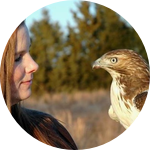Project Results
So what you are looking at doesn't look like much but oh it is soooo much. 🧐 This is a species distribution model for Golden Eagles in AZ. So based on presence points (nest sites) and absence points (no eagles) this map shows where eagles should be nesting. I made another model for Golden Eagle productivity meaning; nests that successfully fledged at least one offspring. This will show which covariates the will predict where and why Golden Eagles should be successful. Also, I scaled all my covariates which is too difficult to explain but it is...as someone smarter than me said...cutting edge!
About This Project
This is part of a larger project that answers the question of why Golden Eagles choose their nest sites in Arizona. Currently, there are no documented studies quantifying Golden Eagle nest site selection in Arizona. This multiscale analysis is essential for understanding the natural history of Golden Eagles in a desert ecosystem. The results from this study will be the foundation of knowledge in which to build on in the future.
Tax-deductible charity EIN: 82-0692138
Ask the Scientists
Join The DiscussionWhat is the context of this research?
Although Golden Eagles are well studied as a species globally, there is little known about them in Arizona due to a lack of research. Prior to 2011, we did not how many Golden Eagles were in Arizona, where they were nesting, how they were doing or the status of their population trend. There is little understanding of their natural history in the desert ecosystems of the southwestern United States. I wanted to know why they were choosing nest sites, what was the nesting productivity of those chosen sites and were humans having an impact on nest failures. In Arizona, there has been an increase in wind power project requests and 'take' permit requests. We must know more in order to provide sound conservation and management policy.
What is the significance of this project?
Nest site selection in Golden Eagles is multidimensional and regionally specific. Golden eagles select nest sites for specific reasons. The high nesting failure seen during the 2012/13 seasons could demonstrate the fitness difficulties for Golden Eagles that choose to nest in a desert ecosystem. In a desert ecosystem, where resources are sparse, quantifying variables that lead to higher productivity will provide the foundational basis to the biology of desert Golden Eagles. Combined with their slow maturity to breed, low reproductive rate and tough habitat, any insult on their survival strategies, such as drought could lead to devastating results to overall persistence. The population trend is unknown; however, it is believe Golden Eagles are declining.
What are the goals of the project?
The results from the data analyses will provide answers to what landscape features are important to Golden Eagles and at what scale (meaning how far from the nest site). They will answer 'Is climate an issue'? The data analyses will answer 'Is human activity having an impact'? on the Golden Eagle and at what scale. These answers are important in order for Arizona agencies to make informed policy decisions when managing the species. Recently, an increase in 'take' permit requests and wind power projects has pressured answers. We need to find out how the species is doing and how they use the landscape and what affects their survival. The answers(results) to these questions will provide that.
Budget
This research is heavy in data analyses and the funds will cover the software, time consulting with collaborators (biostatistician) and the quantitative analyses. The GIS software is at a discount under our nonprofit status which helps with the budget for this project. Without the software and time spent quantitatively with biostatisticians, the data analysis is just not possible. The multiscale analysis and modeling being used are pioneering; therefore, collaboration and time are essential to this process.
Endorsed by
 Project Timeline
Project Timeline
March 1, 2018 - Project launched. Data is prepared. This includes deleting duplicates, organizing nest site UTMs, delineating training data and validation sets.
March-April 2018 - Data Analyses. The data analyses consists of running the data through Random Forests script that will predict the variable of importance and at what scale.
April 2018 - Model Building and Assessment. This consists of fitting and validating the model.
Mar 01, 2018
Project Launched
Mar 30, 2018
Finish Running Scales for Models
Apr 15, 2018
Finish Building and Validating Models
May 01, 2018
Writing Results into Manuscript for Publications and Conference Presentations
Meet the Team
Michele Losee
I love all things, raptor. I am a raptor ecologist and master falconer. When I am not studying raptors, I am flying raptors in the fields of Northern Arizona and when not doing that, I am educating the public about raptors. I love all animals, especially birds, but I have decided to devote my entire life to making the world a better place for raptors. I founded a nonprofit in 2017 called International Raptor and Falconry Center. The mission statement is: Making the world a better place for raptors through education and science.
Project Backers
- 12Backers
- 100%Funded
- $1,102Total Donations
- $91.83Average Donation

